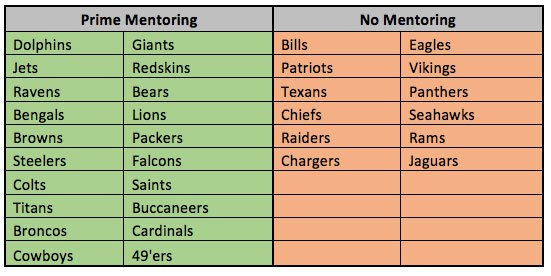Rookie Wide Receiver Mentoring

As the NFL draft quickly approaches, many are analyzing the benefits potential rookie landing spots. One factor I have been curious about is whether elite wide receivers have a positive effect on rookies that come to the same team. During camp each year we hear about veteran wide receivers taking rookies under their wing. Does this accelerate or allow rookie wide receivers to meet their full potential? Is there any statistical evidence to support this idea? If there is, can we use it to help find better dynasty situations and receivers? After consulting with some of the big hitters of DLF, I mined data to attempt to answer this question.
Ground Rules and Assumptions
For this research I will need to set a few assumptions and define a few terms. A good mentoring situation will be defined as a team that has a wide receiver already on the roster with multiple 1,000 yard receiving seasons. In general, players with multiple 1,000 yard seasons are normally considered pro bowl caliber players and are more the type of players we hear about mentoring rookies. I will use the same criteria to determine if a top round draft pick is productive/successful. Conversely, if a rookie never has at least two 1,000 yard seasons, I will consider them a bust for this analysis. This is not really the true definition of a bust, but merely an easy term to use for rookie receivers who underperform for their high draft position. I have used yards as the determining factor because it has the highest single stat correlation to fantasy scoring for wide receivers. For this initial research, I will focus on wide receivers drafted in round one and two since they have the best odds of being the focus of elite veteran mentoring.
Data
The table below shows the distilled mentoring data. It indicates the overall hit rate of wide receivers drafted in the first two rounds of the NFL draft. Hit rate is the percentage of wide receivers that are successful in a dynasty sense, explained above. The table then breaks down the players who fell into mentoring situations and those that did not. There are also columns for round one, round two, and the past five years. The final column covers eleven years because it includes the 2014 wide receivers (there is not enough data to normally include them since we only have one year of scoring). For the 2014 class, I qualified a wide receiver successfully if they had 1,000 yards receiving or were on pace for 1,000 yards based on the games they did play in their single season.
[am4show have=’g1;’ guest_error=’sub_message’ user_error=’sub_message’ ]

Observations
- The rate of a top-two round wide receiver becoming a multi-year 1,000 yard receivers is only 22%. This statistic alone is important to keep in mind while we enter the prime season for rookie fever.
- The mentor situation only adds 4% more hit rate on top of the normal 22% ten year hit rate average. Although, it is worth noting that the mentor hit rate is 8% greater than the non-mentor situation hit rate.
- The mentor hit rate differential rises to 12% when only looking at wide receivers drafted in the first round. The increase from the overall hit rate also rises 6%. It appears from this data that mentoring situation is more important for first round wide receivers.
- The mentoring differential has sharply rose to 21% in the last five years, while the overall hit rate dropped 2%. This is a smaller sample set, but seems indicate that mentoring situation is becoming more important as the league becomes more pass heavy.
The mentoring factor of rookie receivers is not a critical item to take in account when evaluating the potential of rookies due to small increase in hit rate. Although the data has been consistent enough over the past ten years to warrant consideration when deciding between prospects that are ranked closely. The spike in the mentoring effect in the past five years is significant enough to continue to watch and possibly weight more in future rookie dynasty drafts.
Considerations and Flaws
- There are most likely other factors at work besides those from just mentorship. It is possible teams that can support an elite wide receiver are more likely to support another in the future. It may also be true that teams that have the ability to find an elite wide receiver have a better chance to find other elite wide receivers.
- The metrics above do not take into account whether mentoring actually occurred. It is virtually impossible to quantitatively assess the level of mentorship that transpired with a rookie. Thus, all that can be measured is that if elite mentor potential existed.
- The multiple 1,000 yard season line is somewhat arbitrary. A few solid receivers that could have been mentors fell just below the line such Roy Williams and Santonio Holmes.
- A little less than 100 wide receivers have been drafted in the first two rounds of the NFL draft in the last 11 years. This sample size is not a large as I would like to draw strong conclusions and trends.
2015 Rookie Mentoring Landing Spots
The teams listed below currently have at least one wide receiver on the roster that has multiple 1,000 yard receiving seasons and would qualify as mentoring situations in the data above. It is worth keeping these possibly prime landing spots in mind as we evaluate each drafted wide receiver’s potential.

Areas of Further Research
- It is important to monitor the increasing hit rate correlation with mentoring situation in the coming years. If this increase continues, then dynasty owners should increasingly take it into account.
- The correlation of mentoring situations to wide receivers drafted lower and UDFAs could contain some interesting considerations.
- Trying to isolate other variables such offensive situation and team drafting acuity, could help in understanding the true drivers in the increased mentor hit rate.
[/am4show]
- IDP Dynasty Debate: Linebackers - March 1, 2017
- IDP Dynasty Debate: Defensive Line - February 18, 2017
- IDP 20/20: Raekwon McMillan - February 17, 2017


































































